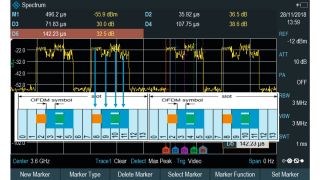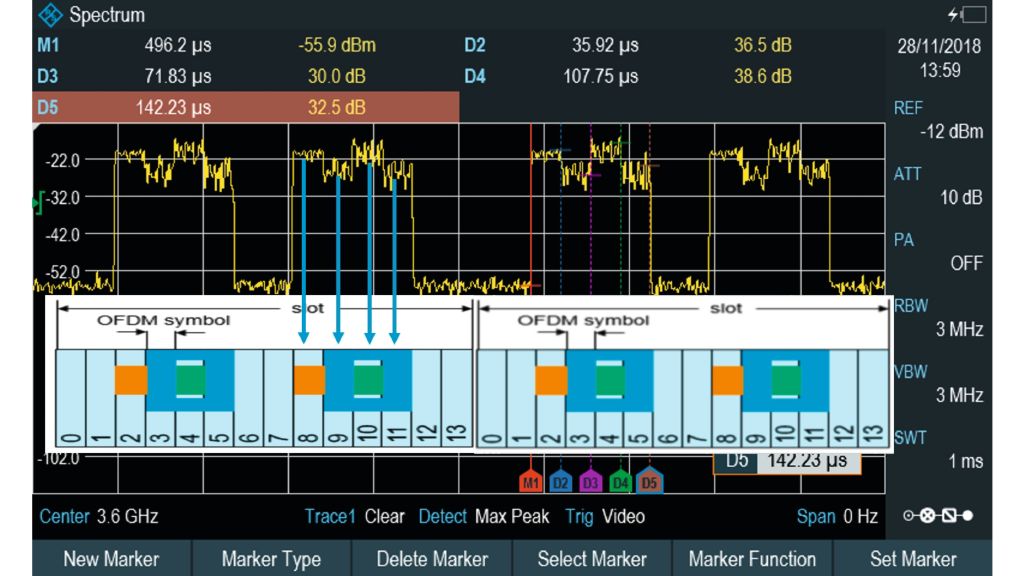Fast 5G waveform verification in the field
Verifying 5G transmitted signals in the field with the R&S®Spectrum Rider FPH handheld spectrum analyzer

Verifying 5G transmitted signals in the field with the R&S®Spectrum Rider FPH handheld spectrum analyzer
Your task
The successful deployment of 5G has created intense demand for improved throughput, latency, reliability and spectrum efficiency. As the number of data hungry applications rises, your task is to ensure that transmitted signals meet 3GPP guidelines with the R&S®Spectrum Rider FPH handheld spectrum analyzer.
Network operators across the wireless industry are in a race to provide the best infrastructure for their customers at the best price. Transmitted 5G DL signals not only have to be compliant; they also have to meet the transmit band parameters.
5G downlink signal
3GPP specifies two frequency ranges, FR1 and FR2. FR1 covers 450 MHz to 7.125 GHz, while FR2 covers 24.25 GHz to 52.6 GHz. Frequencies for 5G tend to be below 40 GHz. In the frequency domain, the synchronization signal block (SSB) consists of 240 contiguous subcarriers (SC). In the time domain, an SSB consists of four orthogonal frequency division multiplexing (OFDM) symbols.
An SSB occurrence in the slot depends on the subcarrier spacing (SS) case type.


Fig.1: 5G NR overview
Fig. 2 illustrates the SSB sequences. SSB is the combination of SS and the physical broadcast channel (PBCH), where the primary synchronization signal (PSS), secondary synchronization signal (SSS) and PBCH with associated demodulation reference signal (DM-RS) occupy different symbols.
Rohde & Schwarz solution
Weighing only 2.5 kg, regardless of frequency range, the R&S®Spectrum Rider FPH handheld spectrum analyzer supports frequencies up to 44 GHz, which covers most of the 5G candidate frequency bands. On a single charge, the analyzer can operate for more than six hours.
The base model performs spectrum analysis measurements such as occupied bandwidth (OBW), channel power, spurious emissions and harmonic distortion, enabling fast interpretation of spectrum analysis measurements. The R&S®Spectrum Rider FPH is an economical, intuitive and rugged instrument. It can be used for spectrum monitoring, RF design validation, interference hunting and RF transmitter testing. In OBW mode, the R&S®Spectrum Rider FPH automatically displays the occupied bandwidth of the 5G downlink signal.
In Fig. 3, the occupied bandwidth is approximately 100 MHz, matching the specified 5G channel bandwidth. The bandwidth of the captured SSB (SS/PBCH signal) also matches the theoretical value of 7.2 MHz (240 subcarriers × 30 kHz SC spacing). Fig. 4 shows the 5G downlink signal in the time domain. Based on the SSB occurrence, this is easily recognized as SC spacing case C. In line with the standard, the theoretical length of a slot is 500 μs and 33.3 μs per symbol, fully matching the transmitted downlink signal.
The lightweight R&S®Spectrum Rider FPH handheld spectrum analyzer can quickly help verify transmitted 5G downlink signals in the field and requires no complicated setup or costly special options.


Fig4: 5G downlink signal with user data in time domain, SC spacing